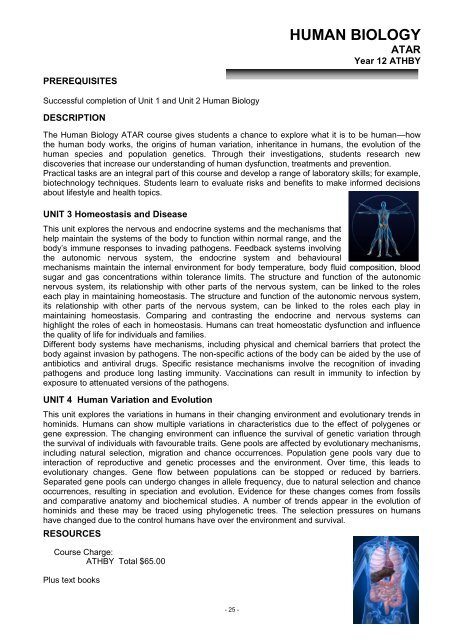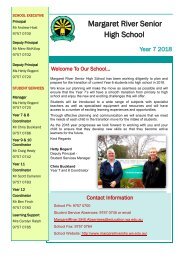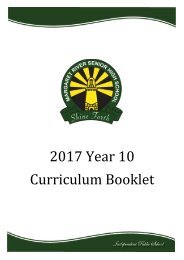2017 Upperschool Course Information
Create successful ePaper yourself
Turn your PDF publications into a flip-book with our unique Google optimized e-Paper software.
HUMAN BIOLOGY<br />
ATAR<br />
Year 12 ATHBY<br />
PREREQUISITES<br />
Successful completion of Unit 1 and Unit 2 Human Biology<br />
DESCRIPTION<br />
The Human Biology ATAR course gives students a chance to explore what it is to be human—how<br />
the human body works, the origins of human variation, inheritance in humans, the evolution of the<br />
human species and population genetics. Through their investigations, students research new<br />
discoveries that increase our understanding of human dysfunction, treatments and prevention.<br />
Practical tasks are an integral part of this course and develop a range of laboratory skills; for example,<br />
biotechnology techniques. Students learn to evaluate risks and benefits to make informed decisions<br />
about lifestyle and health topics.<br />
UNIT 3 Homeostasis and Disease<br />
This unit explores the nervous and endocrine systems and the mechanisms that<br />
help maintain the systems of the body to function within normal range, and the<br />
body‘s immune responses to invading pathogens. Feedback systems involving<br />
the autonomic nervous system, the endocrine system and behavioural<br />
mechanisms maintain the internal environment for body temperature, body fluid composition, blood<br />
sugar and gas concentrations within tolerance limits. The structure and function of the autonomic<br />
nervous system, its relationship with other parts of the nervous system, can be linked to the roles<br />
each play in maintaining homeostasis. The structure and function of the autonomic nervous system,<br />
its relationship with other parts of the nervous system, can be linked to the roles each play in<br />
maintaining homeostasis. Comparing and contrasting the endocrine and nervous systems can<br />
highlight the roles of each in homeostasis. Humans can treat homeostatic dysfunction and influence<br />
the quality of life for individuals and families.<br />
Different body systems have mechanisms, including physical and chemical barriers that protect the<br />
body against invasion by pathogens. The non-specific actions of the body can be aided by the use of<br />
antibiotics and antiviral drugs. Specific resistance mechanisms involve the recognition of invading<br />
pathogens and produce long lasting immunity. Vaccinations can result in immunity to infection by<br />
exposure to attenuated versions of the pathogens.<br />
UNIT 4 Human Variation and Evolution<br />
This unit explores the variations in humans in their changing environment and evolutionary trends in<br />
hominids. Humans can show multiple variations in characteristics due to the effect of polygenes or<br />
gene expression. The changing environment can influence the survival of genetic variation through<br />
the survival of individuals with favourable traits. Gene pools are affected by evolutionary mechanisms,<br />
including natural selection, migration and chance occurrences. Population gene pools vary due to<br />
interaction of reproductive and genetic processes and the environment. Over time, this leads to<br />
evolutionary changes. Gene flow between populations can be stopped or reduced by barriers.<br />
Separated gene pools can undergo changes in allele frequency, due to natural selection and chance<br />
occurrences, resulting in speciation and evolution. Evidence for these changes comes from fossils<br />
and comparative anatomy and biochemical studies. A number of trends appear in the evolution of<br />
hominids and these may be traced using phylogenetic trees. The selection pressures on humans<br />
have changed due to the control humans have over the environment and survival.<br />
RESOURCES<br />
<strong>Course</strong> Charge:<br />
ATHBY Total $65.00<br />
Plus text books<br />
- 25 -










